6 de November de 2023
Top 10 Apps for Strength and Conditioning Coaches
Mobile applications flood our phones, with some being more useful than others. Someone looking to get in shape can download different apps based on their goal: improving strength, running more, practicing yoga or Pilates, training the pelvic floor, or any other objective. Everything is available in the Android and iOS stores. A strength and conditioning coach will seek different apps, as our requirements differ from those of a user looking to get fit. It is very complex to choose the best strength and conditioning apps for a coach, as it is a broad and complex field.
In this article, we outline 10 areas that a coach should handle, and the strength and conditioning apps that can help us in each one. A strength and conditioning app should allow us as coaches to optimize the performance of our athletes, whether it’s improving their strength or endurance, advising them on nutrition (prescribed precisely by a nutritionist), organizing sessions with the client, having a communication channel, and other tasks. In our opinion, these are the strength and conditioning apps, categorized by sections, that a coach should have installed on their mobile device.
1. Vitruve: Measuring the Speed of Load Movement for More Precise Strength Prescription
![]()
The strength and conditioning coach has two very clear functions: to improve the performance of their athlete and to prevent injuries. Both objectives rely on a precise prescription for each training session. Until relatively recently, we had to program strength training based on theoretical aspects and the athlete’s subjective feelings. However, technological advances have made it possible for objective data to determine when to increase intensity and when to stop and rest.
Strength training by velocity is a training method that bases the prescription of exercise on the speed at which we move a load (Zhang et al., 2022). To obtain this data, we have various mobile applications and devices that tell us the speed at which we moved a bar or how high we jumped. One valid and reliable strength and conditioning app is the free Vitruve app (formerly Speed4lifts). You can download it for Android here and for iOS here.
In this article, we explain how to measure bar speed with the free Vitruve app. Simply download it, record your exercise, and indicate when the bar moves and when it stops. This will give you the speed at which you performed each repetition, allowing you to precisely prescribe your athletes’ training. If you’re looking to take a step forward in quality, the Vitruve device allows for direct, valid, and reliable measurements without manual intervention. The app will show you real-time performance parameters such as speed, power, or range of motion, among others.
An example of how useful the app is would be to ask your athletes to perform three jumps in the warm-up to determine if they have recovered from the previous session or match or if they are fatigued. With this vertical jump data, you can request more intensity from your athlete or propose a recovery session because they are fatigued. The free Vitruve app offers much more than measuring vertical jump, but if you want to measure and evaluate vertical jump accuracy, there are other paid apps like ‘My Jump 2′ (Android – iOS). This strength and conditioning app measures the force, speed, and power profile of your athletes’ jumps, as well as other relevant variables such as contact time, vertical stiffness, or the reactive strength index (Balsalobre-Fernández et al., 2015).
2. Vibration Analyzers to Gauge the Intensity of Isometric Exercises like Planks

One of the big challenges as a coach is quantifying effort in isometric exercises like the front plank, side plank, or Copenhagen plank, among others. In these movements, we have to remain still while a set of muscles is under tension. You may have noticed while observing your athlete, or felt it yourself, that as the intensity of the exercise increases, body vibrations also increase. What if we measure and quantify that vibration?
Several authors have already done this in stabilization exercises such as abdominal planks (Barbado et al., 2018) and in balance tests like the Y-balance test (Antón Gil, 2016). ‘Accelerometer Analyzer’ (Android) has been one of the strength and conditioning apps used in these studies to check the vibrations that occur during these tasks. On iOS, there are other apps like ‘Vibration analysis’ (iOS) that serve the same purpose.
The vibration produced by our body during a front plank, for example, is recorded in the app. If the vibration is greater, the intensity is higher. If, after two weeks, the vibration is lower for the same exercise, it means the intensity is lower, or in other words, we have become stronger in that plank or movement. It’s an interesting way to measure progress in these types of planks and isometric exercises where it’s not easy to quantify whether we are doing too little or too much.
3. Interval Timers for Enhancing Physical Conditioning
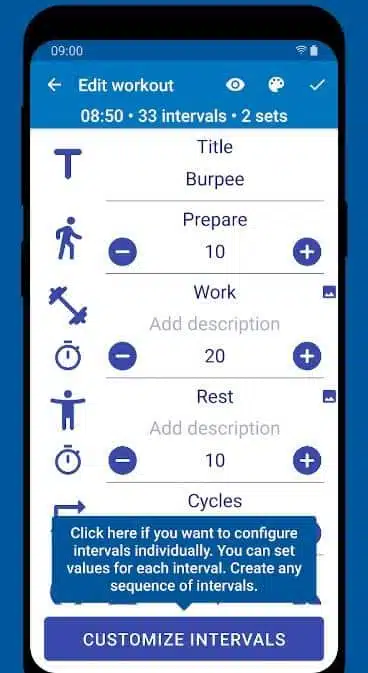
High-intensity interval training (HIIT) is an indispensable tool for improving the physical conditioning of our athletes. If you’re a coach and don’t have an interval timer among your strength and conditioning apps, something is missing. In this category, there is a long list that appears in the App Store when searching for “HIIT” or ‘Interval timer’. Some apps are more intuitive than others, and some are more comprehensive, but the goal of these strength and conditioning apps is to allow us to program a certain number of rounds with a work time and a rest time.
‘HIIT & Tabata: Fitness App’ (Android – iOS) is one of the many examples with which you can program intervals for your athletes. ‘Timer Plus – Workout Timer’ (Android – iOS) is another free application, as well as ‘Tabata Timer: Interval Timer’ (Android – iOS). All of them are very intuitive, free, and fulfill the function we demand in an easy way.
4. Runmatic: Measure Your Athletes’ Running Mechanics to Prevent Injuries and Enhance Performance
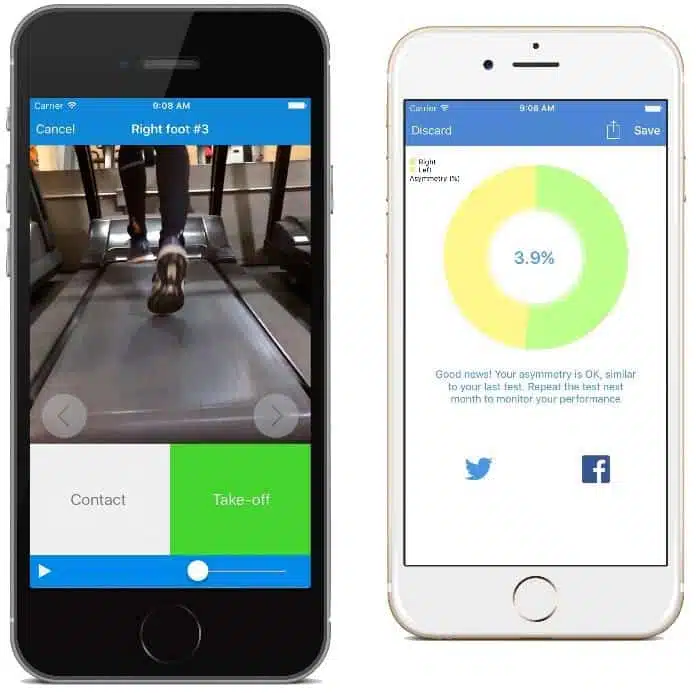
Carlos Balsalobre is a scientist, communicator, and the creator of mobile applications such as the previously mentioned My Jump 2. Another application that might be interesting for analyzing the running technique of athletes is Runmatic (link only for iOS). This strength and conditioning app aims to improve performance and prevent injuries by evaluating how our athletes run: contact-flight times, force, efficiency, frequency, and even leg asymmetry in a straightforward manner (Balsalobre-Fernández et al., 2017).
How does it work? On its website, Carlos Balsalobre explains, “You just need to record 9 steps of your run with Runmatic and select the contact and take-off of each step. Runmatic will magically provide you with valuable information about your running biomechanics and even notify you if something seems wrong.”
5. Training Peaks: Evaluate Physical Endurance with Maximum Precision and Plan High-Quality Workouts
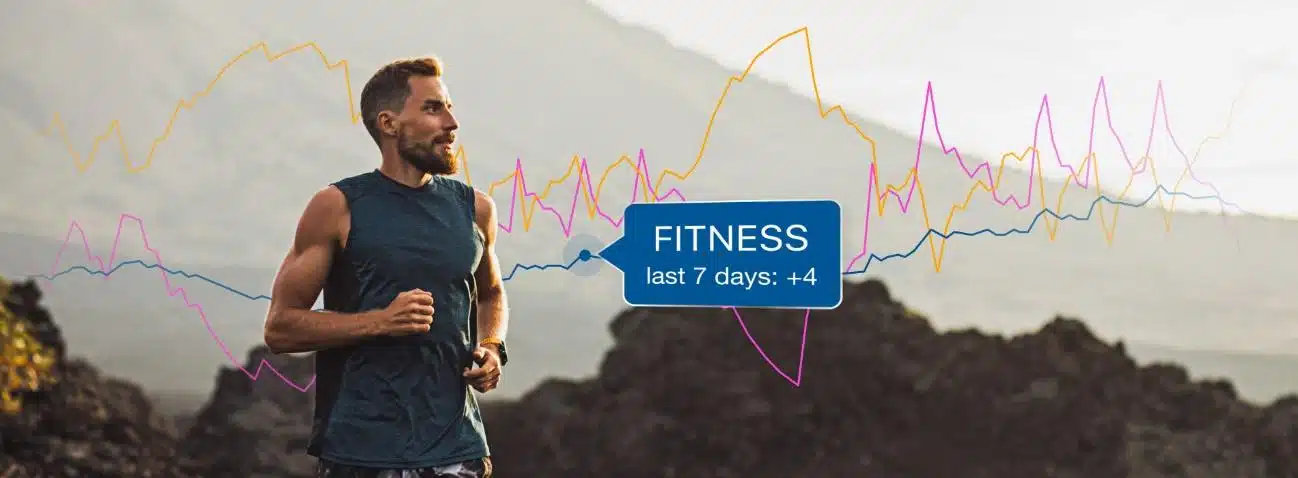
Training Peaks (Android – iOS) is an application primarily focused on improving endurance, but it can be used by strength and conditioning coaches with a high volume of athletes engaged in concurrent training, where both strength and endurance need improvement. This platform is designed to receive information directly from heart rate monitors, power meters, and GPS, allowing the coach to plan based on these data.
More than just an app, Training Peaks is a powerful software that enables coaches to prescribe endurance sessions for their athletes, whether they are runners, cyclists, triathletes, or others. If your athlete is not an endurance athlete, this app may not be of interest to you. However, if you are training or planning to train strength for endurance athletes, Training Peaks can be a great ally.
6. MyFitnessPal: We’re Not Nutritionists, But We Can Offer Guidance on Some Details

El papel de la nutrición debe ser manejado por un dietista-nutricionista. En niveles de élite, encontramos equipos y atletas con varios entrenadores, fisioterapeutas, nutricionistas, psicólogos y otras ramas de la salud y el rendimiento. Sin embargo, a nivel amateur, no contamos con un equipo tan amplio, por lo que podemos proporcionar asesoramiento, que no es lo mismo que prescribir, a nuestro cliente en el ámbito de la nutrición. La aplicación más conocida para esto es MyFitnessPal (Android – iOS).
MyFitnessPal es una herramienta que nos permite registrar lo que comemos y llevar un seguimiento de calorías y macronutrientes en nuestra vida diaria. El proceso de registro es muy sencillo: si el alimento tiene un código de barras, basta con escanearlo; si el alimento no tiene un código de barras, lo introduciremos en el buscador y tendremos todas las opciones entre más de 14 millones de alimentos, ya sea juntos en un plato preparado o por separado. Al final del día, podremos ver si nuestro atleta ha alcanzado los objetivos de proteínas o si ha ingerido más o menos calorías de las necesarias, por ejemplo.
7. Organization and Client Management for Personal Strength and Conditioning Coaches

Alright, coaches, it’s important for us to have some apps on our phones for strength and conditioning, as well as ones to manage our clients, schedules, and all the organizational stuff. There’s a variety of options out there, and their suitability depends on your specific coaching needs. Take a look at ‘Acuity Scheduling’—it’s an excellent application for personal trainers. It helps us keep track of schedules for both ourselves and our clients, and it even automates payments and notifications (available on Android and iOS). There are similar alternatives like ‘Vágaro’ that offer the same functionality—establishing an online presence and managing appointments easily (available on Android and iOS).
Another software solution for coaches that can serve as a strength and conditioning app on our phones is ‘TrueCoach’ (available on Android and iOS). It’s a comprehensive platform for managing clients and delivering their workouts, complete with over 900 exercise videos. You can even upload your own videos or migrate them from YouTube or Instagram. It also enables internal communication with clients, keeping our personal networks and phone numbers separate from work.
If you’re on the lookout for software similar to ‘TrueCoach,’ there’s also the platform ‘PTDistinction’ (available on Android and iOS). It’s highly rated on different review sites like Trustpilot. With this app, you can design programs, conduct assessments, and it integrates with other apps such as ‘Fitbit,’ ‘MyFitnessPal,’ and others, allowing you to track daily habits like eating, sleeping, etc. There are plenty more options in this category that can cater to your specific needs.
Now, let’s talk about ‘Wodbuster’ (available on Android and iOS)—this app is a game-changer for coaches and clients alike. It’s installed on your athletes’ phones, and they handle everything from there. For us coaches, it lets us keep track of class reservations and payments, providing insights into who’s hitting the gym each day and how long they’re staying. Athletes install it on their phones, and from there, they can view their training history, check out the plan for the week or day, and see if there’s an open slot because someone else canceled, and so on.
8. Anatomical and Biomechanical Analysis of the Athlete
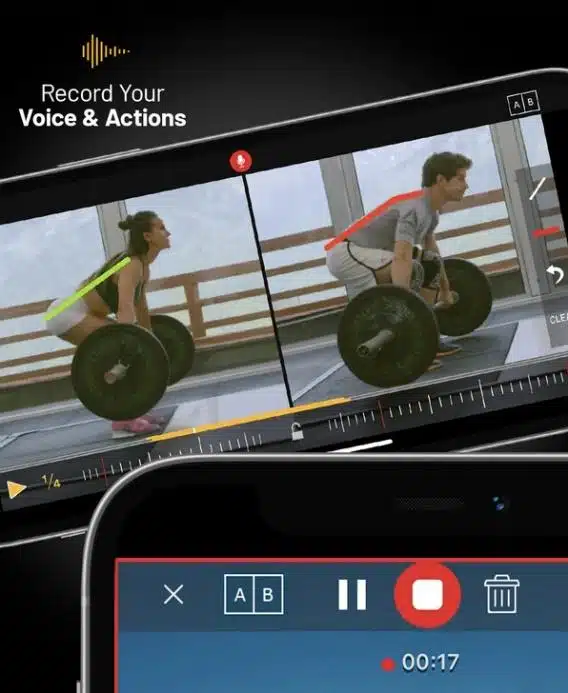
They say a picture is worth a thousand words, so there’s nothing clearer for our clients than seeing which muscles they’re working on with each exercise. Many times, we need to ask the athlete to focus on a specific muscle group, such as the glutes, to avoid over-activating the hamstrings. Whether it’s for that reason or simply to enhance the quality of our explanations on an anatomical and biomechanical level, we have the ‘Strength by Muscle & Motion’ app (Android – iOS) at our disposal.
This strength and conditioning app boasts over 5.5 million users worldwide. It features a library of over a thousand biomechanically analyzed exercises and more than 200 educational videos for correct postures and executions. The download is free, and if you want to make the most out of it, there’s a subscription option.
If you’re looking for something more analytical to capture video of your athlete and provide feedback on their execution, ‘myDartfish’ (Android – iOS) could be a winning choice. This strength and conditioning coaching app is straightforward to use and provides comprehensive technical information to our athletes. The process involves recording your athletes with your phone, and within the same video, you can pinpoint errors, like a knee valgus in a tennis stroke, or check the angle formed with the hip in a specific movement. With the stopwatch and measurement tools, you can also track execution times and overlay your voice on the video for the athlete to see and hear the correction simultaneously. It has an extensive list of features, such as measuring the bar path in an Olympic lift or evaluating errors during the lift.
9. Pocket Goniometer: Assessing Athletes’ Joint Mobility on the Go
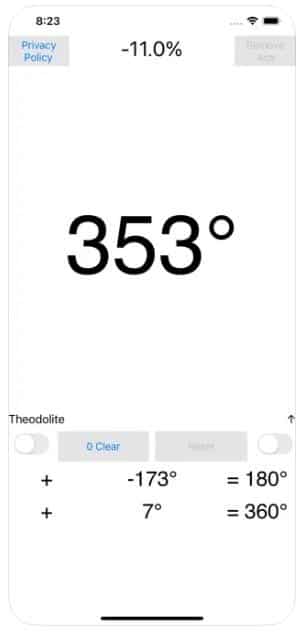
This section might seem like a bit of a silly thing for some coaches, but for others, it could be a discovery in the realm of strength and conditioning apps. There are situations where we want to measure a body angle in our athlete, either in a specific movement or during some mobility test. A clear example of the importance of degrees of movement is seen in baseball pitchers, where we need to pay attention to the degrees of internal and external rotation of the shoulder. In cases like this, we can have an app like “”Inclinometer Protractor” (iOS) installed on our device.
Is this the best app for measuring body angles? In my opinion, yes. I use it, and in a second, I can determine, based on the inclination of my phone, the angle formed by a joint. There are many others available, as in all sections, so you can try different ones and compare, but “Inclinometer Protractor” is so basic that it provides the information we need without frills, and it’s free.
10. Every Detail Counts: The Menstrual Cycle Matters, A Lot

The final section is dedicated to an application that can significantly impact or slightly influence athletic performance but has been overlooked for a long time: the menstrual cycle. If your athletes are women, it’s crucial to monitor the menstrual cycle, especially if there are significant performance differences among them, particularly during the days surrounding menstruation, which often lead to the most significant performance declines. Something as simple as tracking your athlete can make your programming much more successful.
It’s a complex issue that sometimes goes unnoticed because some athletes don’t show significant differences throughout the menstrual cycle. However, some women display substantial variations between the late follicular phase, the days leading up to menstruation, and the mid to late follicular phase, where higher intensity can be introduced.
The app ‘FitrWoman’ (Android – iOS) is one of the most commonly used for tracking the menstrual cycle with the goal of maximizing each woman’s individual performance. For coaches, there’s the ‘FitrCoach’ platform where you can access a dynamic control panel displaying the records your athletes have entered into the ‘FitrWoman’ app. This way, you can anticipate the effects of each menstrual cycle phase and tailor sessions to introduce more intensity at one point in the cycle, unload at another, and be cautious about injuries during the ovulatory phase, which tends to have a higher risk.
References
Antón Gil, C. (2016). Propuesta de intervención de un programa de estabilización de tronco cuantificado mediante Smartphone para la mejora del equilibrio unipodal y los cambios de dirección en futbolistas. http://dspace.umh.es/handle/11000/2830
Balsalobre-Fernández, C., Agopyan, H., & Morin, J. B. (2017). The validity and reliability of an iPhone app for measuring running mechanics. Journal of Applied Biomechanics, 33(3), 222–226. https://doi.org/10.1123/JAB.2016-0104
Balsalobre-Fernández, C., Glaister, M., & Lockey, R. A. (2015). The validity and reliability of an iPhone app for measuring vertical jump performance. Journal of Sports Sciences, 33(15), 1574–1579. https://doi.org/10.1080/02640414.2014.996184
Barbado, D., Irles-Vidal, B., Prat-Luri, A., García-Vaquero, M. P., & Vera-Garcia, F. J. (2018). Training intensity quantification of core stability exercises based on a smartphone accelerometer. PloS One, 13(12). https://doi.org/10.1371/JOURNAL.PONE.0208262
Zhang, X., Feng, S., Peng, R., & Li, H. (2022). The Role of Velocity-Based Training (VBT) in Enhancing Athletic Performance in Trained Individuals: A Meta-Analysis of Controlled Trials. International Journal of Environmental Research and Public Health, 19(15). https://doi.org/10.3390/IJERPH19159252

